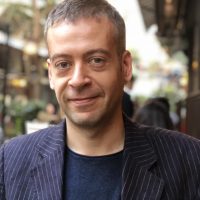Public
Discourse
Award
An ode to Marmara
published by Eurozine , Austria
What lies below the sea snot spectacle
In 1996 I caught a jack mackerel. It was my first fish. My uncle showed me how to catch it. We were sailing on Marmara Sea. The small boat moved to and fro as our flasher rig disappeared into crystalline waters. The rig contained ten small hooks decorated with baits. Ismet, my uncle, is a Turkman from the sealess Iraqi city of Kerkuk. He was ecstatic to be fishing after sunset, instructing me to cherish the moment: ‘This is the life!’
We returned triumphantly to our summer house’s wooden pier. Just before dinnertime, I carried buckets into the kitchen. Crickets began chirping as neighbouring houses sank into silence. Uncle Ismet started grilling mackerels. Seated around a small table, family members washed them down with rakı, Turkey’s national drink. Uncle Ismet offered a sip. I took a few, proceeding to mix the smoky drink with cold beer, which turned out to be a rookie mistake. Listening to Nirvana’s In Utero on our porch, my head started spinning.
These same waters once flowed into the heart of a civilization, inspiring poetry, paraded in paintings, feeding a cornucopian culinary culture. They are, for the most part, the reason why we live here. Marmara calms us in moments of anxiety. Orhan Pamuk, Istanbul’s greatest chronicler, wrote: ‘There’s not a problem that a walk by the Bosphorus can’t fix.’ When the meditation app Headspace reminds me, ‘just above the clouds, remember the blue sky is always there,’ I think of Marmara as a similarly reliable layer.
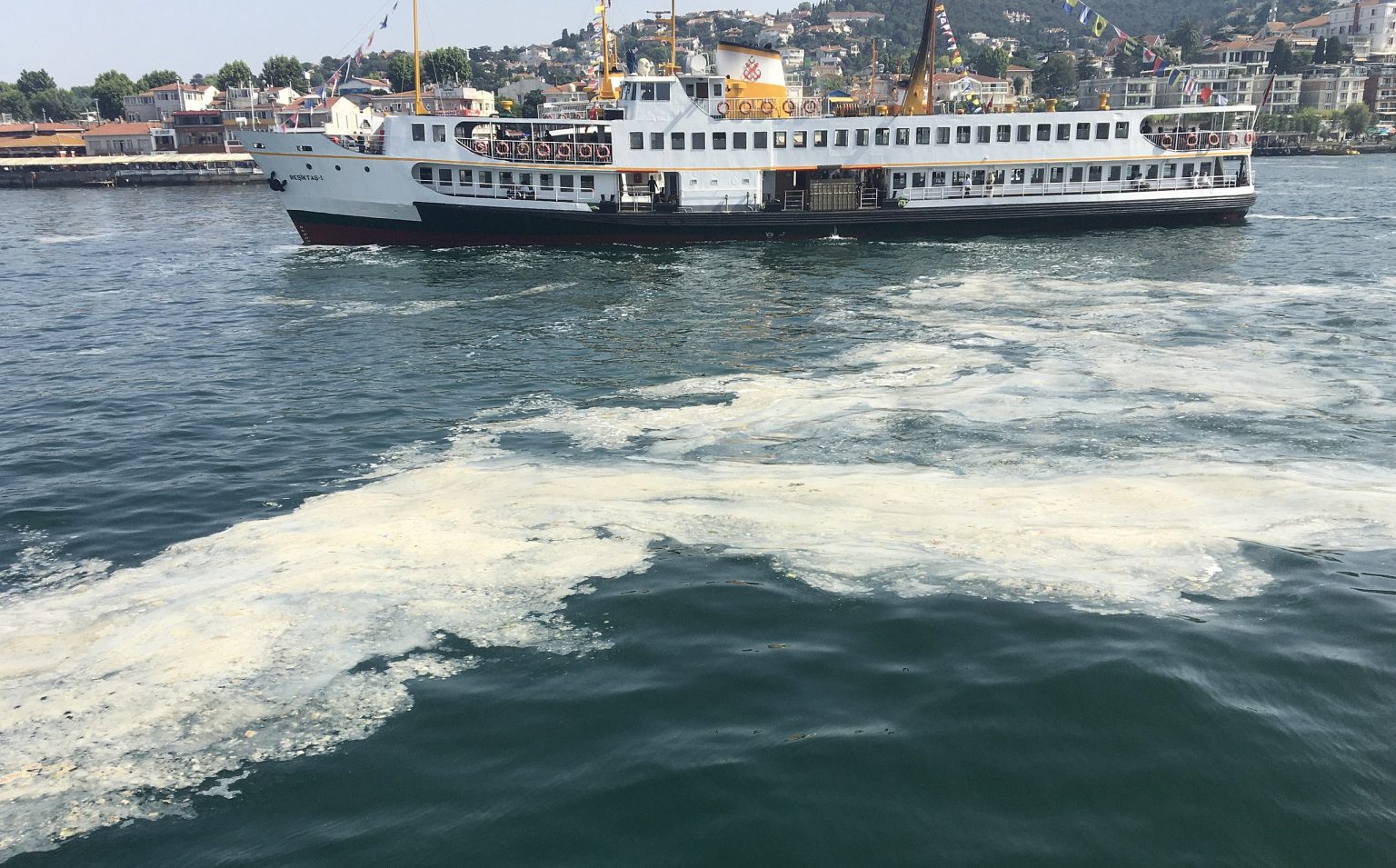
Marine mucilage, popularly known as sea snot, photographed on Marmara on 1 July 2021. Image by Furkan via Wikimedia Commons.
The memory from my youth remains vivid, and yet, a quarter of a century later, I realize that dining on freshly caught fish is becoming history. This May a thick layer of marine mucilage, popularly known as sea snot, started to take over Marmara. The gelatinous organic substance turned opaque this inland sea which connects the Aegean to the Black Sea, a visual sign announcing its marine life’s death. The superficial international media hype rattled locals for its treatment of mucilage primarily as a spectacle. I first saw it in June this year, on my way to a ferry: a mirage, as if land began to extend into the sea. All that was liquid had turned solid. It also resembled the skin of a terminally ill patient.
Soon afterward, fish started dying in lakes and rivers surrounding Marmara. In Lake Küçükçekmece, a lagoon that lies on Marmara’s European shore, waves swept hundreds of dead fish ashore. Around the Bosphorus Strait, athletes struggled to row on the thickening surface. Mucilage invaded propellers of outboard motors; fishers showed nets covered with that slimy substance to cameras. The fishing season, they said, was over. Professional divers observed that most fish had fled to deeper waters. The visibility undersea fell to less than half a meter. Marine life near Marmara’s surface had gone extinct.
Nowadays, this cloud-coloured substance is eating up my source of calm, and Marmara is struggling for breath before our eyes. Like a caught fish, it’s asphyxiating. Experts predict the worst, warning that a rotten egg smell may soon take over the city. For those living and breathing in Istanbul, Marmara’s death is a personal matter, and finding the perpetrators is a moral duty.
Byzantine abundance
In classical antiquity, this ancient Greek city, Byzantium, owed its wealth to fish and was known by its moniker, ‘tuna’s motherland.’ Two things drove most profit to Byzantium: fees collected from ships crossing the Bosphorus, and fishing.
Directly opposite Byzantium stood their great rival Chalcedon (Kadıköy today). Two towns competed fiercely to catch more fish, but the stream of Bosphorus gave Byzantium an advantage, turning mackerel routes from Chalcedon to Byzantium’s way. According to legend, fish would swim near a shining bright white rock on the Bosphorus before changing direction, approaching Istanbul’s Golden Horn, and ending up in Byzantine hands. To celebrate their abundance, Byzantine fishers sacrificed a tonne of tuna to Poseidon, asking the gods to help them with their next hunt.
In Politics, Aristotle lists Byzantium’s fishermen while discussing classes in public life. In spring, they would pick a hill overlooking Marmara, climb a tree and monitor fish movements. Having identified a large group, they would yell at the top of their lungs to notify fishers who awaited to trap their prey with nets.
In Fish and Fishery in Ancient Era Istanbul (2010), ancient history scholar Oğuz Tekin notes how Derkos, a Marmara lagoon, abounded with fish in Byzantine times. The best fishing spaces on Marmara were Baltalimanı, Tarabya, the Golden Horn, and the Prince’s Islands. Fishers used harpoons to hunt dolphins, and fishing was such a big part of life that Byzantium issued bronze coinage, in the name of Sabina, wife of the emperor Hadrian (who ruled between 128 and 137 CE), featuring on its reverse a pair of tuna.
Even Istanbul’s neighborhoods received their names from fish: Dionysios Ostredoes was named after oysters. Today the neighborhood is named Tophane and is home to Orhan Pamuk’s Museum of Innocence which features the replica of a fish eaten by one of the eponymous novel’s characters.

Marmara is an inland sea connecting the Aegean and the Black Sea. It was known as Propontis in antiquity. Hilmi Şahenk’s photo shows an aerial view of Tarabya, an Istanbul neighbourhood on the European side, from 2014. Via Wikimedia Commons.
Marmara contains two streams: one from the Black Sea to the Aegean, and from Marmara to the Black Sea. These streams flow on different levels: the Black Sea moves between 30 to 40 centimetres above Marmara. The Italian natural scientist Luigi Ferdinando Marsili was the first to spot this difference in 1681. Because of it, Marsili noticed, Marmara was two seas.
The Black Sea’s marine creatures, who tolerate significant changes in sea temperatures and salt levels, lived in its upper stream; their neighbours in the bottom were Mediterranean sea animals with much-diminished adaptation skills. These streams featured a unique migration pattern. In the winter, tuna and mackerel would travel from the greater Mediterranean, the Aegean, and Marmara to Pontos Euxeinos (the Black Sea). As winter neared, they would pass the Bosphorus and head to Marmara. In the autumn, as cold northern winds blew to disrupt the Black Sea, the first mackerels would arrive at the Bosphorus, only to return to the Black Sea in early spring. In 2004, during excavations on the Byzantine port of Theodosius (current day Yenikapı), archaeologists found bones of tuna, mackerel, and dolphins – remnants and reminders of a culture built on fish migration.
The fish of Turkey
In 1915, Karekin Deveciyan, the Director of Istanbul’s Fishery Office, published Fish and Fishing in Turkey, one of the first scientific studies on the subject. Deveciyan was an Armenian born in Harput, an ancient Ottoman town, and served numerous offices related to fishery in Ottoman bureaucracy.
But Deveciyan’s passion was for books. He translated fiction by Alexandre Dumas père before turning his fishery expertise into a comprehensive book. Devoting years to classifying and documenting Marmara’s fish, he used government funds to publish a tome whose expanded edition, Peche et Pecheries en Turquie, appeared in 1926.
‘I’ve counted each thorn and bone of every fish species in Marmara,’ Deveciyan wrote in that book’s introduction, specifying that fishermen had been consulted.
This Armenian expert of Marmara lived in an era of abundance. In Derkos, fishers caught over 100 thousand kilograms of fish each year in the 1920s. In his book, Deveciyan identified 124 fish species of commercial importance from Marmara and listed 42 dalyans (fishing weirs) on Istanbul’s waters. He also found 59 volis, net-casting places used by Marmara’s fishers.
Writing from his refuge in France, the exiled Ottoman Sultan Abdulmejid II praised Fish and Fishing in Turkey in a 1923 letter to its author. The last caliph was not much of a monarch, but he was a skilled landscape painter whose views of Bosphorus are delightful: Çamlıca’dan Adalara Bakış offers a view of Marmara lined by Istanbul’s Princes Islands; in Yolcu Gemisi Marmara’s waves wash gloomily against a city ferry.
Until Abdulmejid’s death in exile in 1944, Marmara retained its glamour. When Deveciyan died in 1964, it was still abounding with fish. ‘The Bosphorus’s biodiversity remained rich until the 1970s,’ writes Asaf Ertan, a former fisherman whose family roots go back to an Ottoman sailor named Ömer Ağa, who assisted Ottoman Sultan Bayezid I to build a fortress at the entrance of the Göksu river in 1389. In his memoir, Fishing on the Bosphorus (2010), Ertan writes evocatively about seals taking refuge in boat sheds of dilapidated Bosphorus mansions, fishers tying nets to their window railings, a harmonious existence of city and sea.

Fishing on the Bosphorus in 2021. Photo by Haluk Cömertel, CC BY 3.0 via Wikimedia Commons.
But fish species significantly reduced after the 1980s as Marmara’s pollution began. By the late 1970s, the 127 fish species Deveciyan listed in 1915 had shrunken to sixty. That number would keep falling dramatically to twenty species by 2010. To understand what transpired in those thirty years, I called Levent Artüz, a leading Turkish hydrobiologist whose grandfather, Cemal Artüz founded the Turkish Biology Foundation.
Cemal’s son İlham Artüz also devoted his life to studying Marmara, launching the MAREM project (‘Changing Oceanographic Conditions of the Sea Of Marmara’) in 1954 with fishing biologist Olav Aasen. This makes Levent Artüz a third-generation scholar of Marmara. He took over MAREM after his dad’s death and began giving his college lectures on oceanography and sea pollution. ‘I was born into the Bosphorus,’ Artüz tells me, ‘I’ve spent my teenage years diving, sailing, trying almost all of the water sports. My childhood was populated by sea scholars, thanks to my dad.’
Dramatic decay
Artüz points to October 1989 as the starting point of Marmara’s troubles: the month Marmara began to turn into a cesspool of feces. ‘Before that, Marmara was a healthy sea,’ he said. ‘47 fish species lived in Marmara, and the only problem was surface pollution around industrial cities. Because Marmara was crystal clear, people considered the occasional rubbish on its surface a problem.’
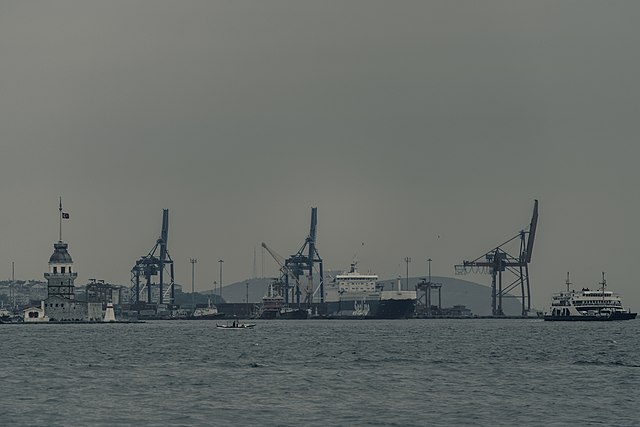
Cranes over Marmara. A 2018 photo by Mostafa Meraji via Wikimedia Commons.
The real problem was the swift industrialization around the Golden Horn as factories on its shores pumped toxic waste into its waters. I recall how, over the 1980s, we used to roll up our car windows to avoid the area’s awful odor: a mixture of shit and rotten eggs. The local government invented a project to cleanse Golden Horn which paved the way for our current mucilage crisis. Istanbul’s blue-eyed mayor, Bedrettin Dalan, promised to ‘turn the Golden Horn’s shade to my eye colour.’ A World Bank-funded project was set to become the world’s largest wastewater treatment facility. Located in Istanbul’s Baltalimanı, it would process all the home waste from Istanbul’s Asian side.
Instead, authorities opted for a technique known as deep-sea wastewater discharge. It repurposed the stream leading to the Black Sea as a conveyer belt, which they hoped would push the Golden Horn’s dirt into the Black Sea. A component of the ‘Istanbul canalization project,’ the technique continued under the right-wing Dalan’s social democrat successor Nurettin Sözen, who rose to power in 1989. (When Recep Tayyip Erdoğan became Istanbul’s mayor in 1994, he sustained the project which remains in place to this day.)
By late 1989, weeks after the system first launched, booming comb jelly populations created island-sized red patches on Marmara. Fish deaths were first seen between Üsküdar, Kartal, and the Prince’s Islands. Three years later, Marmara’s colour turned to an extreme shade of green. In September 1995, sea walnuts invaded Marmara and anglers couldn’t fish for two years. Scientists found poison in Marmara’s white sand mussels, once a bringer of profit. Marine organisms called phytoplankton caused the poisoning (they’re also the cause of the mucilage crisis). By 2000, white sand mussel fishing was banned in Marmara. In 2010 the number of Marmara’s fish species fell to five. Sea urchins took over many of Istanbul’s coasts; in 2012, invader species like pufferfish, reigned in its waters. Artüz thinks there is no turning back from this. ‘We lost Marmara in 1989 beyond repair.’
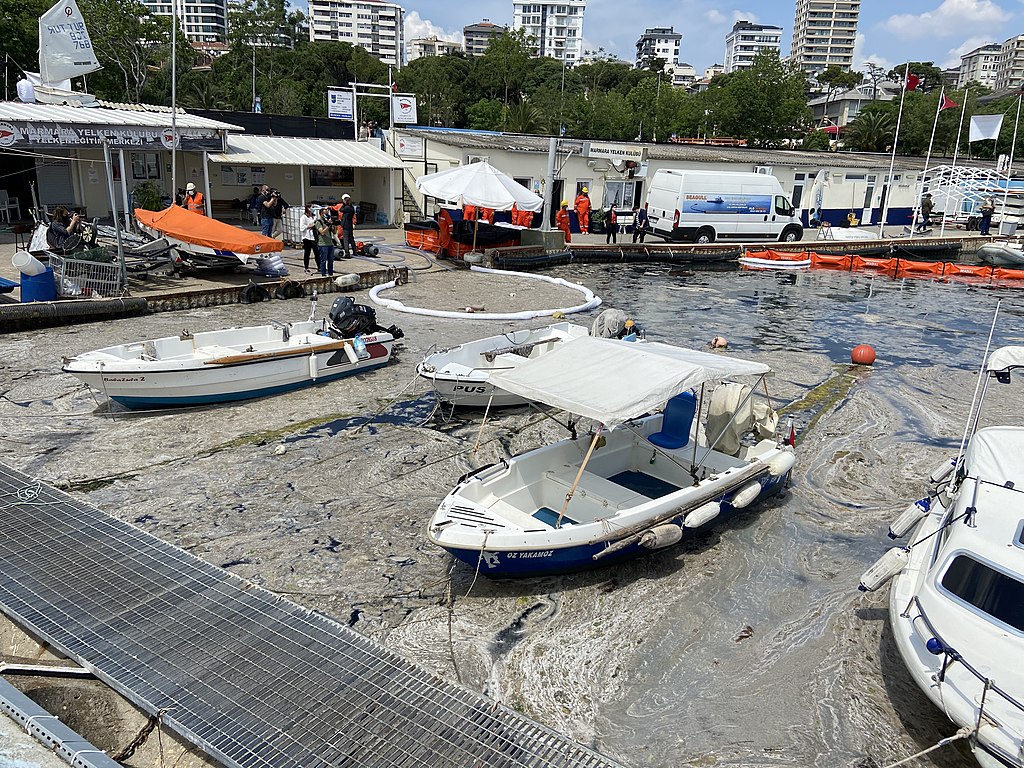
Marine mucilage surrounding boats in a mariona on the Marmara, photographed on 8 June 2021 by Hilmi Hacaloğlu. Image via Wikimedia Commons.
A crisis foretold
For Bülent Şık, one of Turkey’s most outspoken public health experts, Marmara was the stuff of dreams. He first saw it in 1977, at the age of ten. It was June, the schools just closed, and he was excited to be passing for the first time the Bosphorus Bridge, which opened in 1973. ‘My heart pounded like crazy.’ Şık’s family spent the summer there, and he relished swimming in the Küçükçekmece lagoon.
Şık spent more than half of his professional career working for the government. As a food safety advisor to the Ministry of Agriculture, he toiled at laboratories, analyzed toxic chemicals, reported on water pollution, and acted as a whistleblower when he shared his knowledge about toxic chemicals in Marmara in a series of articles for the opposition newspaper Cumhuriyet in 2018.
Şık had gleaned that information between 2010 and 2015 while, alongside his academic work at Akdeniz University’s Food Safety and Agricultural Research Center, he worked for the government’s Public Environmental Health project, documenting instances of water and food pollution in Kocaeli, Edirne, Kırklareli, and Tekirdağ to ponder whether the toxic chemicals of these Marmara towns had a tie with the rise in cancer cases in the area. ‘We found that the Ergene brook carried grade-four heavy polluted water quality,’ he tells me. ‘We also identified pollution brought by Ergene’s waters to Marmara.’
Instead of changing its policies after Şık’s exposure, the government began pumping all the polluted waters of Ergene tributary to Marmara from December 2020. ‘Having read the literature on this I can easily say that the technique that begins with Dalan, continues with Sözen and peaks with Erdoğan, is against the scientific theory of deep discharge,’ Şık says. Instead of cleaning the water, he adds, ‘all the dirt is collected, merged with home and agricultural waste – and pumped somewhere between thirty to fifty meters under the sea surface. This is the same thing as sweeping the dirt under the carpet at home.’
Still, the system has remained in place for thirty-two years. It’s applied in places like Tekirdağ, Bursa, and Kocaeli: summer houses, marine resorts, all the residential areas around Marmara practice deep-sea wastewater discharge and pump their waste into this fabled and once pristine sea. ‘If this continues until September, we’ll definitely lose the Black Sea,’ says Artüz, ‘we’ll also be putting the Aegean at great risk.’
Worryingly, Şık warns that one fatal consequence of our mucilage crisis is a potential cholera outbreak. (A previous cholera outbreak in 1970 killed around fifty people.) ‘The mucilage layer creates an environment ideal for the E. coli bacteria whose levels increased by a thousand times in these areas since we started seeing mucilage,’ Şık notes. ‘Such public health crises are inevitable when an ecosystem collapses.’
After mucilage became evident in May with the rise in sea temperatures, people’s first question was whether they would be able to swim or go fishing. ‘How can we clean this ugly thing?’ they asked, as the sea snot ruined their glorious selfies. It was as if pollution was not of our making but of Marmara, a sea that we cared for only when we needed to. To fix the problem, Turkey’s Environmental Ministry had been collecting mucilage to cleanse the surface – a hopeless task – since early summer. It also organized a large conference on mucilage and issued an action plan with twenty-two articles.
These are, at best, palliative solutions. ‘What’s the use?’ asks Artüz. ‘Marmara had already been in this state five years ago. Nothing was done to protect it until the sea ran out of oxygen. What do you do if your house is on fire? You first shut down the gas and electricity. Then you call the fire brigade. Instead, the government is organizing workshops. Someone has to shut down the gas and electricity from their valves first. Otherwise, this fire will get bigger.’
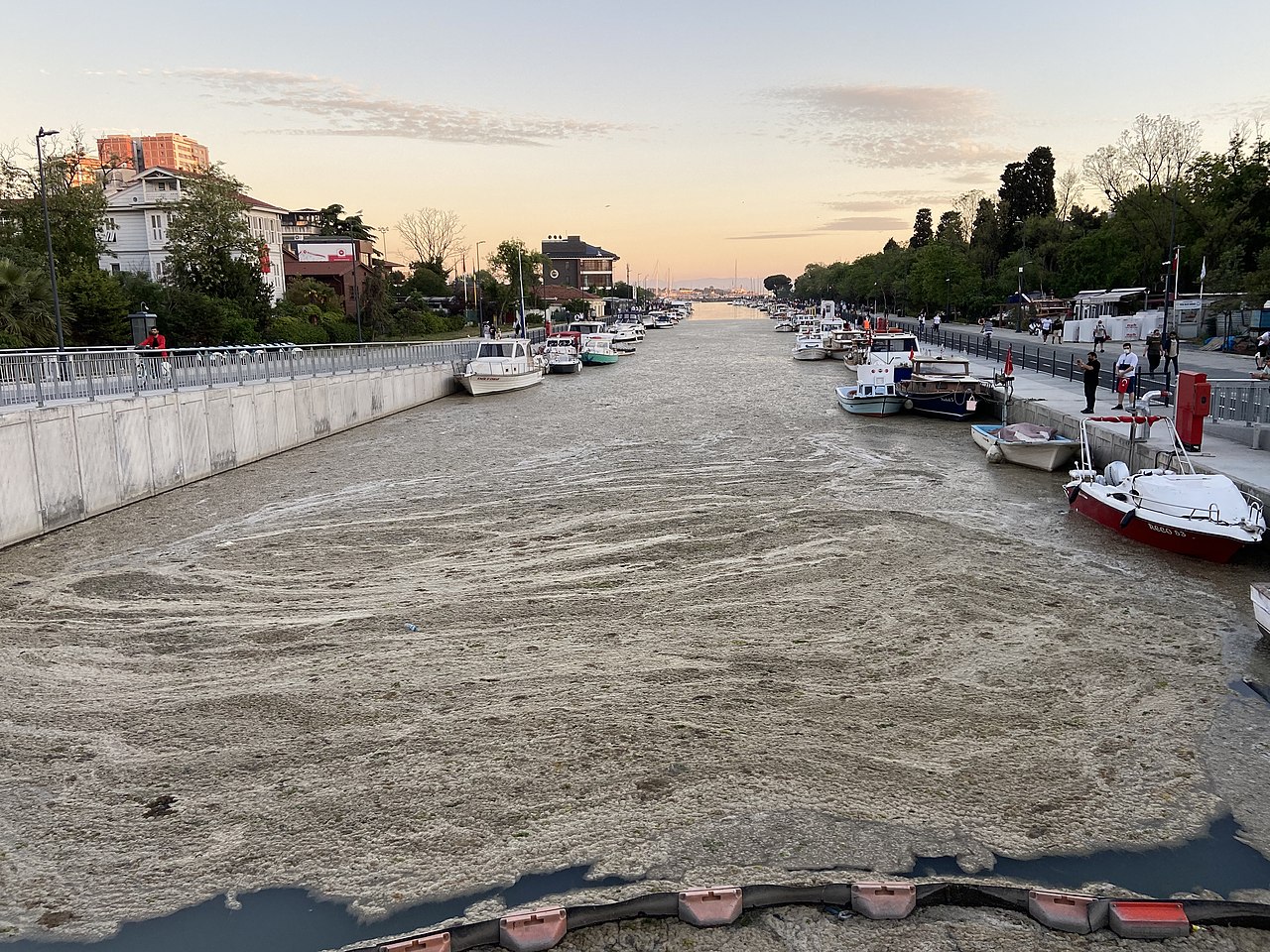
Sunset over sea snot in a Marmara marina. As phytoplantkon thickens in the polluted sea, the water turns slimey and is no longer habitable for fish. Photo taken on 19 May 2021 by Hilmi Hacaloğlu. Image via Wikimedia Commons.
The final assault
We ponder nature through poetry and music and treat it as a beautiful object to appreciate. But in fact, nature is ruthless. It follows its own path and when we disrupt it, it may morph into alarming novel forms. The best we can do, at this point, is perhaps to remember Marmara’s history. ‘We’ve slowly killed this culture; not much is left,’ says Artüz.
Istanbul is a city of global importance. But it still lacks a natural history museum where kids can visit and get to know the species of the Bosphorus. Do we know about the flower Istanbulensis or many of the other Marmara-specific sea species named after this city? Do we know about butterflies who exclusively live here? We don’t. And as long as we don’t, this culture will continue to vanish.
Thirty percent of the Turkish population, some 24 million people, live in the Marmara region and some may claim that this pollution is inevitable. But the more and more unhinged construction projects of the ruling Islamists counter that argument: their ‘Canal Istanbul’ will create an artificial sea-level waterway to connect the Black Sea to the Sea of Marmara, delivering the final blow to tuna’s motherland. ‘Whatever we can do we should do it now,’ says Şık.
The first step must be to halt Canal Istanbul. Those who insist on building it are also aware of what it will do to Marmara’s pollution. If you spend 40 minutes reading a report you get the full picture. This is not about ignorance.
Instead, he proclaims, this is about government-linked tycoons putting their economic interests before public health. ‘They see each element of our seas and lagoons as gates to profit.’
Scholars like Şık and Artüz were ignored for years. After his reports on water pollution, the government attempted to lock Şık up: he was sentenced to 15 months in prison in 2019, but was acquitted earlier this year. And when Artüz wrote a book titled The Recent History of the Pollution of Marmara Sea four years ago, Turkish publishers ignored him. Nowadays, he has their ear. ‘Five of the leading publishers approached me to get the manuscript,’ he laughs. ‘There may be many books like mine, which didn’t see the light of day.’ And yet the mucilage, he notes, concerns the death of not only healthy waters but a whole culture.
Over the past half decade, the word Boğaziçi itself began to vanish from Istanbul’s culture. As the culture of martyrdom replaced the calm of Bosphorus, the Bosphorus Bridge’s official name was changed to ‘The Martyrs Bridge’. Bosphorus University, the country’s highest ranking higher education institute, is under assault by the government who want to tame it through loyal placeholders.
But still, despite the heated rhetoric and severe pollution, despite the plans for further and more severe destruction of Marmara, this fluid culture keeps on flowing. Hopefully, it will outlive those whose ignorance and ill will Marmara is suffering – and lovers of this sea shall never forgive them.





